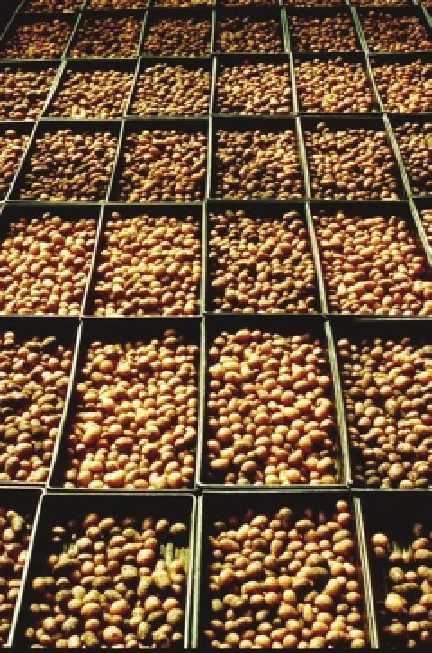Agriculture Reference
In-Depth Information
annual basis and have periodic grow-outs in the
greenhouse to verify they have not mutated and
are true to type (Stark and Love, 2003; Sather
et al
., 2013). These mother stocks then become
the source for increasing the cultivar via micro-
propagation.
The multiplication takes place by cutting
between the individual nodes of each plant and
inserting these nodes into artificial media under
aseptic conditions. New plantlets grow from
each axillary bud within a short
2-
to
3-
week
period and the plantlets are available for cutting
and propagating. The multiple cycles of propaga-
tion make it quite easy to increase plant numbers
rapidly without the spread of pathogens. Using these
techniques, it is possible to increase one plantlet to
over 2500 within a period of
3-
4 months. After the
desired quantity is achieved, the producer can move
the plantlets into the greenhouse or screenhouse
to produce minitubers. Alternatively, they may
be moved directly into the field as plantlets after
hardening, or for other uses as described above.
It is also possible to increase the number of
plantlets by cutting the plantlets while they are
in a seedbed substrate. This is a reliable method
for multiplying seed tubers if the
in vitro
plantlets
are of high quality. In Dalat, Vietnam, growers cut
the plantlets from the seedbed over
20
times
through a
6-
month growing period (Uyen and van
der Zaag, 1985). Producing plant cuttings in the
seedbed can also reduce space while reducing
the overall costs of the production of minitubers.
The methods used in tissue culture have not
changed greatly over the decades, and information
is readily available online at industry websites such
as the Food and Agriculture Organization (FAO)
and the International Potato Center (CIP). There
have been many innovations and improvements
specific to potato tissue culture, such as the use
of containers with new shapes (square or round
boxes, tubes, etc.), the use of improved media
(liquid and solid) for growing specific cultivars,
media formulations (with or without sugar),
automatic filling of the vessels for large-scale
production, use of energy-saving lamps or nat-
ural lighting, and light-reflecting shelves. With
innovations and improvements, the efficiency of
producing
in vitro
plantlets has increased greatly,
while simultaneously decreasing the costs of
multiplication. There is much potential for a
greater use of the technology around the world,
even in relatively poor regions.
Minitubers
The most common form of tissue culture mater-
ial used is the minituber (
Fig. 8.3
). Minitubers
are produced in greenhouses from clean plant-
lets using sterile soils, grown in systems using a
nutrient film technique (Wheeler
et al
., 1990) or
a hydroponic system (Rolot and Seutin, 1999;
Chang
et al
., 2012). All methods allow the pro-
ducer to use fewer tissue culture plantlets for the
process and still produce high numbers of mini-
tubers (multiple tubers per plant) grown in a
soil-less environment, thus removing the threat
of soilborne diseases. Additionally, the tubers
tend to be very uniform in size.
However, the disadvantage to either system
is the high investment cost to start. The prolifer-
ation of various techniques to produce minitu-
bers has been beneficial in reducing the costs of
the initial starting material. Research has been
conducted to increase the yields of minitubers.
Milinkovic
et al
. (2012) discuss the increase in
the yield of tubers when an induction period has
Fig. 8.3.
Minituber production from a greenhouse
facility in Colorado, USA.

